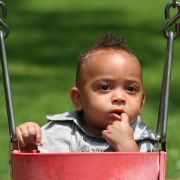Theory of Mind (original) (raw)

Children begin to develop theory of mind between ages 3 and 5. Researchers have identified that children often progress through five milestones as they develop theory of mind abilities, although the sequence of them varies across different cultures.
- The recognition that other people may have desires different from one’s own.
- The recognition that people may have different beliefs on the same topic.
- The understanding that people draw from different bases of knowledge.
- The understanding that others can hold false beliefs.
- The recognition that people can hide their true emotions.
Infants are not born with an understanding of what others think. The first step in developing theory of mind occurs around 6 months of age, when infants begin to gain the ability to detect faces and follow someone else’s gaze.
Another milestone in the development of theory of mind is imitation. As babies develop, they begin to imitate the actions of their parents or those around them. Examples include clapping, smiling, and games like peek-a-boo. Around age 1, babies will also start to recognize where others pay attention, such as when parents point to something and the child follows their finger to see what’s being pointed at.
The growth of theory of mind continues as children begin to play and speak. The interactions of play help children learn what to expect next from others. Speech, and stories, in particular, help children understand the inner desires and beliefs of protagonists and antagonists.
Around age 4, children begin to understand that other people can believe things that aren’t true. These are called “false beliefs.” There are several methods by which theory of mind can be measured in children, but the most common is a false-belief task. In a false-belief task, children are told a story and must infer the expected beliefs of the characters.
Theory of mind continues to develop throughout childhood and into adolescence, as the brain develops and children acquire more life experience.
According to researcher Victoria Prowse, children with a strong theory of mind at age 8 are more likely to succeed academically in adolescence. Higher levels of this ability appear to account for as much as half of academic achievement, according to her research.